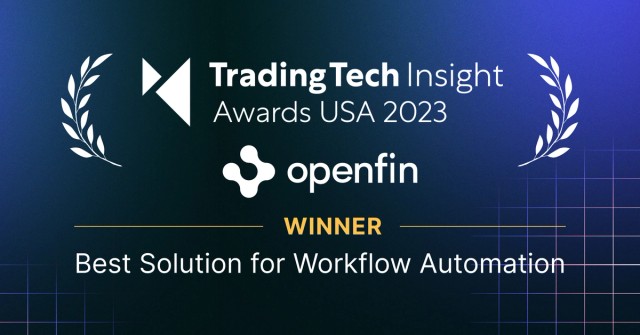September 16, 2019
Transforming The FX Trader’s Desktop

This article was first published on eft.World, original publication can be found here.
As the industry gathers for TradeTech FX in Barcelona this week, we talk to Adam Toms, CEO of OpenFin Europe, about the latest trends in FX trading and the work OpenFin have been doing with BNP Paribas to transform their FX workflows
The FX market is clearly unique in comparison to other asset classes. What is it that makes this space attractive to OpenFin?
The fragmentation of the FX market is really what sets it apart from other asset classes not to mention FX is the biggest financial market in the world. The decentralized nature of the FX market leads to the fragmentation of applications, different analytics, price data feeds and so on. For this reason, and for the fact that it’s a very electronic market, the sheer quantity of applications in the FX space is remarkable. In fact, a recent WBR survey found that 40% of respondents said increasing on-desk technology is the top challenge facing FX trading desks in 2019. It’s all too easy for a trader desktop to become cluttered to the point of disrupting workflow, and that’s where we can make a big difference.
What are you hearing from the FX professionals you speak with? How do they define success when it comes to new FX initiatives?
Many FX professionals are finding themselves in a kind of paradox: they have access to more data than at any point in the past, but the information overload makes it harder than ever to access relevant insights. When it comes to the desktop, they need easier navigation, better visualization and more effective alerts. Currently, there are eight platforms leveraging OpenFin technology to enhance their applications in the FX space, and all have addressed at least one of these issues. As a result, we’re not only helping traders navigate this market with greater precision and efficiency; we empower traders to take more control over their desktop technology and workflow, to drive increased performance.
Tell us one of your FX success stories. How is the firm using OpenFin and what are the intended effects?
The case of BNP Paribas comes to mind. BNP leveraged OpenFin to improve their Cortex app, an advanced multi-product FX trading platform. It was a significant build, involving a complete facelift into HTML5, but their FX trader workflow is now completely transformed. Cortex now features a dramatically changed look and feel, with a major focus on visualization and alerting. They created a digital assistant to help traders navigate the application. In addition, BNP is leading the way delivering higher transparency into the FX market and the algorithms they operate. Ultimately, they are looking to achieve deeper integration with clients, broader application interoperability and seamless deployment and updates, all of which can be achieved by working with OpenFin.
FX has traditionally lagged behind equities in terms of automation. Where do you see this space in that process? Is the gap narrowing?
The gap has certainly been narrowing and fast. We’ve seen a tremendous rise in algorithmic trading over the past few years in the FX market and high frequency trading has been present for some time. The overall level of order transparency in the FX markets is still somewhat challenged but improving, meaning traders are making more informed decisions and executing with confidence leveraging the algorithms available. A recent survey conducted by WBR revealed that 20% of FX traders see reducing the human touch at the trading desk as their top priority, so the automation trend looks poised to continue.
What are some of the other macro trends you’ve observed within the FX space?
As far as market trends, one to keep an eye on is the broader ‘equitization’ of FX markets – that is, FX markets seeing increased levels of algorithmic trading, TCA and other technologies that improve execution quality and data insights. Looking at the desktop specifically, visualization and alerts are proven means of cutting through the noise and helping traders get exactly what they need out of a given platform, and we expect this trend to continue given the highly electronic and fragmented nature of the FX market. We know many of operators leveraging OpenFin have a number of innovative enhancements planned for the FX market, so watch this space!
Enjoyed this post? Share it!
Related Posts
All Posts ->
Featured
We’re changing our name to Here™
Press

Featured
From Fragmentation to Automation: How OpenFin Workspace Has Catalyzed Digital Transformation for the Desktop
Press